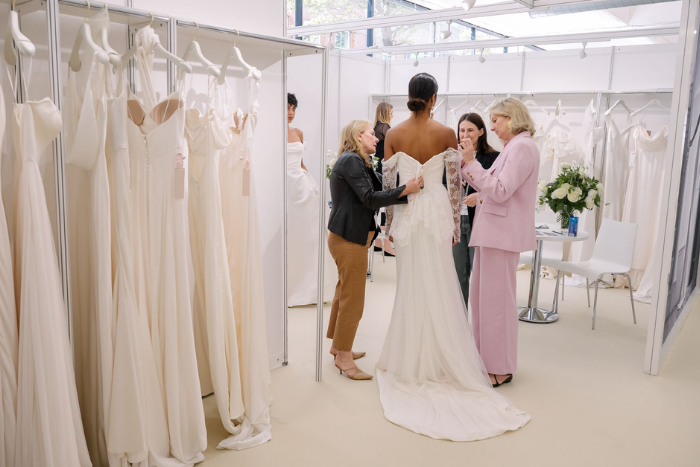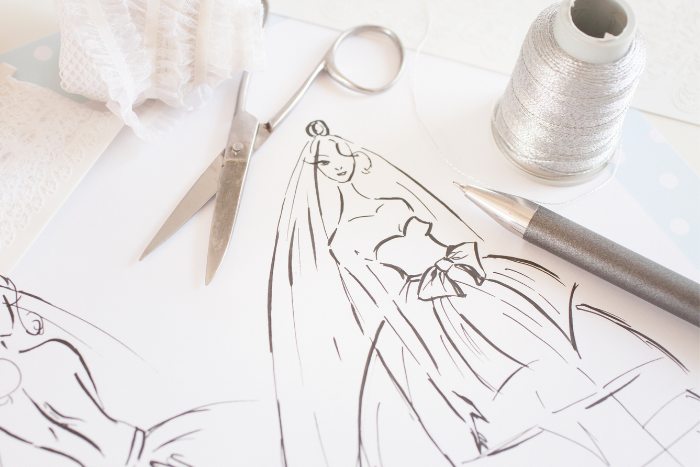Setting up shop
“Starting a bridal business can be a daunting task,” Jane Watson says. “First you need to do your homework – lots of it. Your initial and most important step is a visit to BBEH, where you must speak to suppliers to glean as much information as possible from them. Visit wedding fairs to get a feel for the industry. Check the web to see which designers the shops in your chosen location are stocking. Chat to friends, family and work colleagues about their experiences when buying wedding dresses and note down all your findings. Hang around outside supermarkets and monitor women going in and out to get an idea of shapes and sizes in the area – this will help you when ordering your samples.”
Advice and finance
Before you sign on any dotted lines, seek professional advice. Business Link, FSB (Federation of Small Businesses) and BIRA (British and Independent Retailers Association) offer good, free general business advice and it is worth considering becoming a member of one of them for ongoing support once you are established. Some have agreements with banks to offer credit and debit card terminals and good percentage terms on the plastic.
Will you need a loan? If so, you’ll need a realistic business plan and constructive advice so you are prepared for any questions the bank may throw at you at the interview. This is just the sort of thing Jane Watson can help you with. Alternatively, you need to find yourself a local accountant.
Consider other ways of financing your business – do you have savings or equity in your home? Perhaps these funds could be used instead of applying for a loan. Your local Chamber of Commerce may offer a grant to help you with your website design – check out all that is available to you out there.
Advertising and promotion
When working out how much money you need, as well as taking into account rent, stock, staffing, insurance and decorating the shop, make allowance for an advertising/promotions budget – but make sure you stick to it! Your suppliers will mostly have their own websites – and if you become a valued stockist you may be listed on their site.
Some suppliers advertise in bridal magazines – this can provide you with another opportunity for your shop to be featured as a stockist. Ask your suppliers about these options. Your own website should have lots of key words to attract brides when they are surfing the net. List your suppliers with a direct link to their websites so a bride can see the complete collection she may be able to purchase from you.
Check out bridal, fashion and beauty features in the local press and take part if your advertising budget allows. Some newspapers and magazines offer free editorial space to their advertisers – push for this. In-store promotions are crucial, too – such as designer days, and Valentine’s, Easter and Christmas events.
Customer service is paramount – first impressions really do count. You can’t sit at your desk reading a magazine – you need to speak to your clients. Never, ever start with: ‘Can I help you?’ – if they say: ‘No,’ that’s the end of the conversation! Try saying something about it being a nice day, or ask them when the wedding is – anything to draw them into conversation.
Premises
Brides will travel far and wide to find the perfect dress, so it is not vital that your shop is on a high street; the rent will be cheaper in a ‘secondary’ location. However, a passing trade is good to have as is plenty of parking nearby.
Contrary to what you may think, having no competition in the area is not necessarily a good thing – if there is more than one bridal shop in the vicinity a bride may be more keen to come to the area and spend the day looking for her dress.
Try to avoid a shop with two floors – the rent will be higher and you will need more staff. Premises on a five-year lease with a three-year break clause are ideal – this gives you time to establish your business, start slowly and build up your knowledge of the industry. Once successful you can decide whether to renew the lease or move to bigger premises. After two years’ trading you should have a fair idea of how you are doing – the three year break clause gives you the opportunity to get out on your third anniversary if you feel that there is no point in continuing, or if you want to expand.
Interior design
“Designing your shop’s interior is the fun part!” says Jane. “My advice is to keep it simple. Have lots of mirrors strategically placed, small tables and chairs for an intimate chat with your clients, and good-sized fitting rooms. Make the showroom inviting and play soft music so it is not deadly quiet when a customer walks in. Plug in scented air fresheners, buy fresh flowers…and display stock so that all the dresses can be seen easily – just five or a maximum seven dresses per metre rail. And change the window display weekly.”
Suppliers
When it comes to selecting suppliers avoid any designers which are stocked by your competitors; most designers will not want to supply to you if they already have successful stockists in your area. Start out with four collections and about 40 to 50 samples in total so you can purchase a good repreentation of designs from each supplier. Make sure you have dresses in a range of price bands – but don’t underprice or outprice yourself for your area.
Building up a relationship with your suppliers is absolutely fundamental to the success of your business. If you are loyal to them, you can expect loyalty in return. Make sure you understand their policy in supplying the competition, how many new samples you will be expected to buy at each show, what the payment terms will me (usually 30 days from date of invoice). Some designers will offer exclusivity but you cannot expect that if you only sell a few of their gowns per year.
Bridesmaids
Consider carrying a collection of bridesmaid dresses. Jane says that these should be adult dresses as these days it is more often than not the best friends who play the part.
“These best friends, if not already married, are your future brides – send them away to a competitor to buy their bridesmaid dress and they will most likely go to that same competitor to buy their bridal gown,” says Jane. This really does make sense. Make them feel special while they are still the bridesmaid, start building a relationship with them and hopefully they will come back when it is their turn! Children’s bridesmaids’ dresses, meanwhile, can be bought almost anywhere for less than you can sell them for, so if you feel you must offer them, just settle on a couple.
Open day
The best time to open a new shop is September – most brides will start looking then for a wedding the following year. January is also a good time as brides getting married later in the same year will start looking then. Keep opening times simple and regular – for example 10–4 Monday to Friday, 9–5 Saturday. Open the same number of days as the shops around you. It’s not a good idea to close on a Monday as brides often put aside a long weekend to go dress-hunting.
“Owning your own shop is like being in show business,” says Jane. “Think of it as a stage – when you step onto it you have to perform, however you may be feeling! You have paying customers and they expect a genuine show. Get it right and it could be the best show in town – the one that everyone is talking about clamouring to get in to.”
Jane Watson runs a highly-successful bridal business consultancy offering just the sort of help that anyone who is starting out needs. Many years in the trade – designing dresses, owning retail bridal shops and exhibiting at all the major trade shows – made her aware that there was a need for a consultancy to help both new and existing businesses.
See here Jane’s new article on starting or enhancing a bridal business











